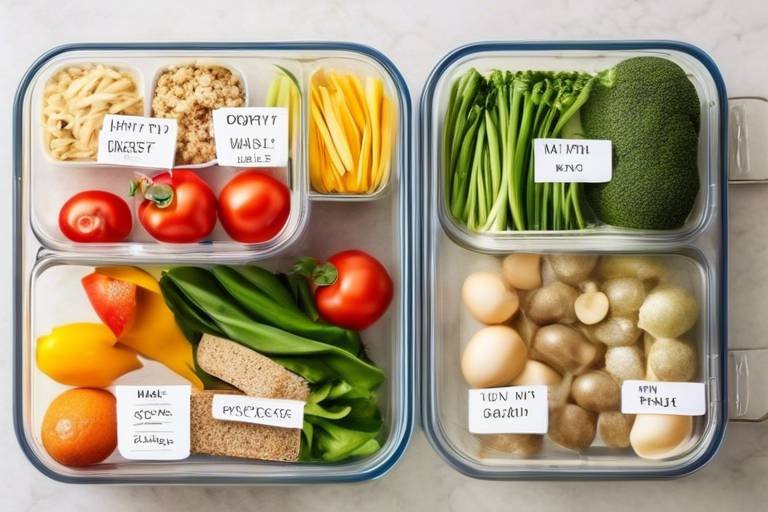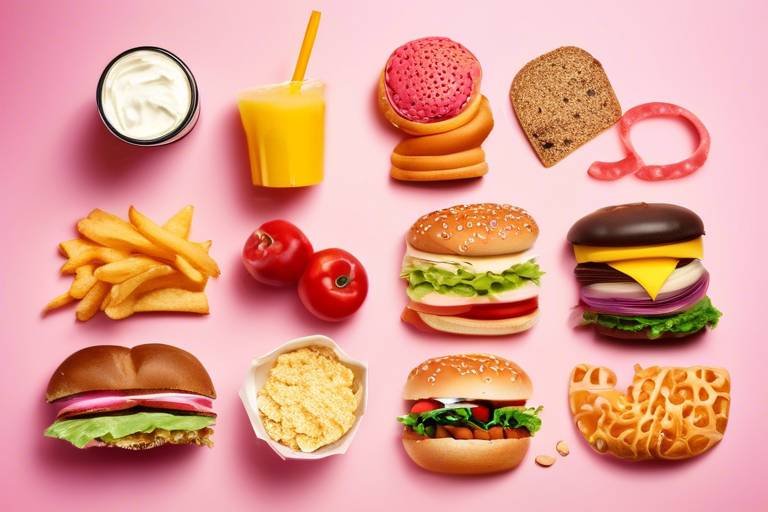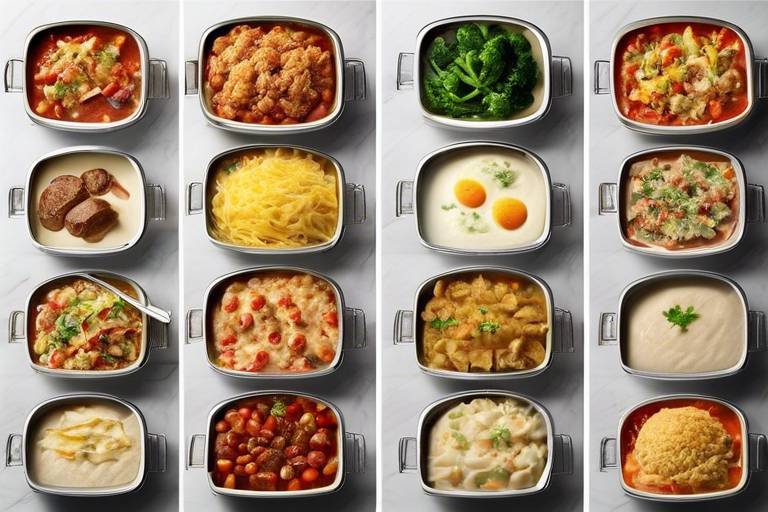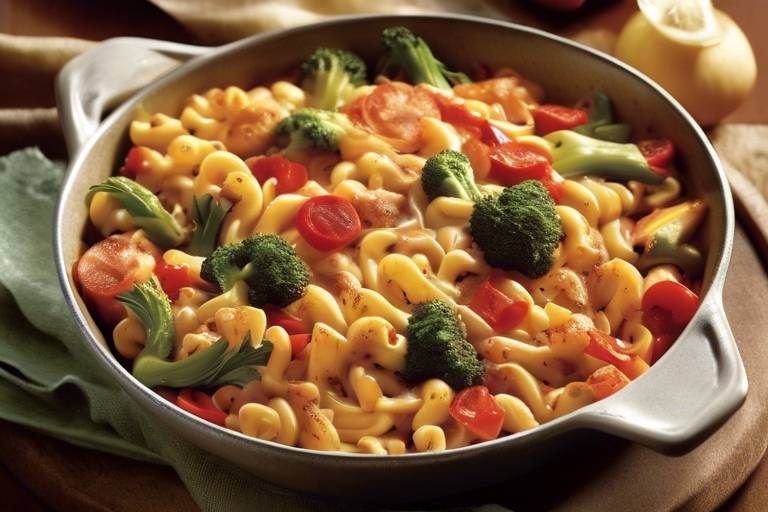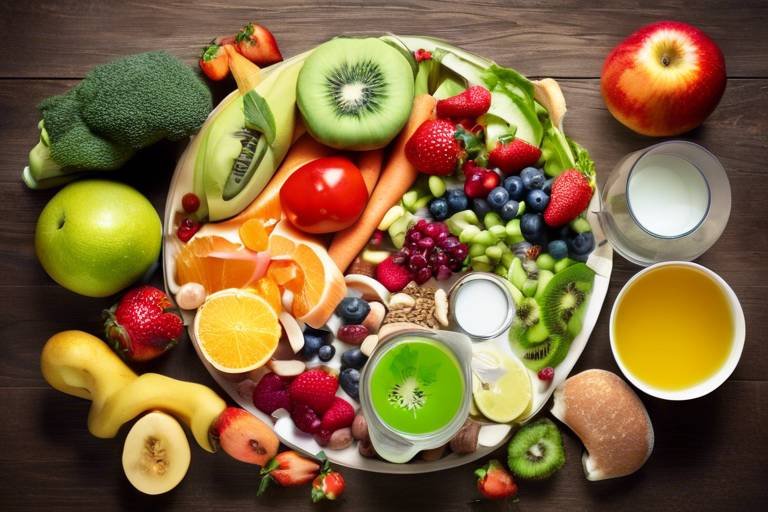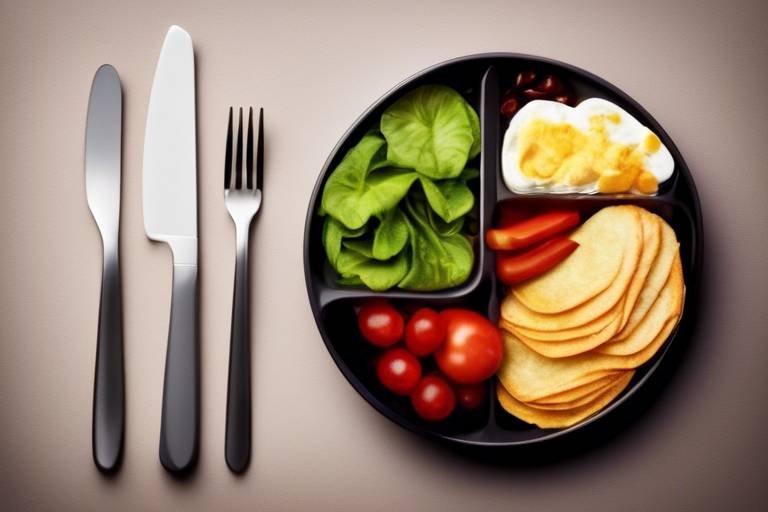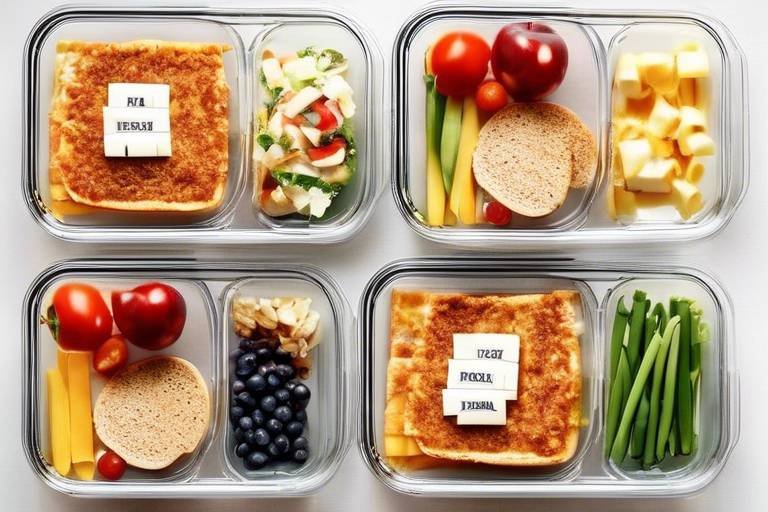Using Meal Planning to Lower Your Grocery Bill
Have you ever found yourself staring at your fridge, wondering how on earth you spent so much on groceries yet still have nothing to eat? You're not alone! This common dilemma can be tackled head-on with a little bit of meal planning. By taking the time to plan out your meals for the week, you can not only save a significant amount of money but also ensure that you're eating healthy and delicious foods. Imagine walking into the grocery store with a clear plan, knowing exactly what you need, and avoiding the dreaded impulse buys that can quickly derail your budget.
Meal planning is like having a roadmap for your culinary journey. Instead of wandering aimlessly through the aisles, you’ll be equipped with a list that reflects your nutritional goals and financial limits. It’s a strategy that leads to less food waste, as you’ll be purchasing only what you need for your planned meals. Plus, you’ll find that cooking at home can be a fun and creative outlet, allowing you to experiment with new recipes and ingredients without breaking the bank.
So, how does one embark on this meal planning adventure? It starts with understanding the benefits. Not only does meal planning help you save money, but it also reduces the stress of figuring out what to cook each day. You’ll find yourself making healthier choices, as you can prioritize nutritious meals over last-minute takeout. The key is to set aside a little time each week to strategize your meals, create a shopping list, and stick to it when you hit the store.
In this article, we'll dive deep into the various strategies for effective meal planning. From setting a budget and assessing your current spending to choosing the right recipes and shopping smart, we’ll cover everything you need to know to make meal planning work for you. So grab a pen and paper, or your favorite note-taking app, and let’s get started on this journey to a healthier and more economical way of eating!
Meal planning can lead to significant savings and reduced stress. Learn how it can improve your shopping habits, enhance your diet, and help you avoid impulse purchases.
Establishing a grocery budget is crucial for effective meal planning. Discover how to create a realistic budget that fits your lifestyle and helps you track your spending.
Before setting a budget, evaluate your current grocery expenses. This assessment will provide insight into where you can cut costs and allocate funds more efficiently.
Recognizing which grocery items take up most of your budget allows for better planning. Focus on strategies to reduce spending on these items without compromising nutrition.
A monthly grocery budget helps you plan ahead and avoid overspending. Learn how to break down your budget into weekly allocations for better tracking.
Selecting recipes that utilize similar ingredients can minimize waste and save money. Explore tips for choosing versatile meals that fit your budget and taste preferences.
Effective grocery shopping techniques can maximize your savings. Discover strategies such as making lists, using coupons, and shopping sales to ensure you get the best deals.
A well-organized grocery list helps you stay focused and avoid impulse buys. Learn how to create a list based on your meal plan to streamline your shopping experience.
Keeping an eye on sales can lead to substantial savings. Understand how to plan your meals around weekly promotions and discounts to maximize your grocery budget.
Managing leftovers effectively can prevent food waste and stretch your budget further. Explore creative ways to repurpose leftovers into new meals while saving both time and money.
Transforming leftovers into new dishes can add variety to your meals. Discover inventive recipes that make the most of what you have on hand.
Proper storage can extend the life of your leftovers. Learn best practices for storing food to maintain freshness and reduce waste.
- What is meal planning? Meal planning is the process of planning your meals for a specific period, typically a week, to save time and money.
- How does meal planning save money? By planning your meals, you can create a shopping list that focuses on what you need, reducing impulse purchases and food waste.
- Can meal planning help with healthy eating? Yes! Meal planning allows you to prioritize nutritious foods and avoid unhealthy last-minute choices.
- How often should I plan my meals? Most people find that planning once a week works best, but you can adjust based on your schedule and preferences.

The Benefits of Meal Planning
This article explores effective meal planning strategies that can help you save money on groceries while maintaining a healthy diet. Discover how to streamline your shopping and reduce food waste.
Meal planning is not just a trendy buzzword; it’s a game changer for your wallet and your well-being. Imagine walking into your kitchen, knowing exactly what you’re going to cook for the week, and having all the ingredients ready to go. Sounds blissful, right? By investing a little time upfront, you can enjoy a plethora of benefits that make meal planning worth every minute.
First and foremost, meal planning leads to significant savings. When you take the time to plan your meals, you can create a grocery list that focuses only on what you need. This eliminates those pesky impulse purchases that often inflate your grocery bill. Think of it like going on a treasure hunt with a map; without a plan, you might end up wandering aimlessly and spending more than you intended.
Additionally, meal planning can reduce stress. How many times have you found yourself staring blankly into the fridge at 6 PM, wondering what to whip up for dinner? With a meal plan in place, you can skip that frantic scramble and enjoy a more relaxed cooking experience. You’ll have the peace of mind knowing that you’re not just throwing together random ingredients but rather crafting delicious meals that align with your dietary goals.
Another significant advantage is the improvement in your overall diet. Meal planning allows you to incorporate a variety of nutrients into your meals, ensuring you’re not just relying on the same old takeout options. You can make a conscious effort to include more fruits, vegetables, and whole grains, which can lead to better health outcomes. Plus, when you plan your meals, you can focus on cooking at home more often, which is generally healthier than dining out.
Moreover, meal planning helps you avoid food waste. When you know what you’re going to cook, you can purchase exactly what you need, leading to less spoilage. According to a study by the Natural Resources Defense Council, up to 40% of food in the United States is wasted. By planning your meals, you can contribute to reducing this alarming statistic while also saving money in the process.
In summary, the benefits of meal planning are vast and varied. From saving money and reducing stress to improving your diet and minimizing waste, it’s a strategy that pays off in multiple ways. So why not give it a shot? You might just find that it transforms not only your grocery bill but also your entire approach to cooking and eating.
Establishing a grocery budget is crucial for effective meal planning. Discover how to create a realistic budget that fits your lifestyle and helps you track your spending.
Before setting a budget, evaluate your current grocery expenses. This assessment will provide insight into where you can cut costs and allocate funds more efficiently.
Recognizing which grocery items take up most of your budget allows for better planning. Focus on strategies to reduce spending on these items without compromising nutrition.
A monthly grocery budget helps you plan ahead and avoid overspending. Learn how to break down your budget into weekly allocations for better tracking.
Selecting recipes that utilize similar ingredients can minimize waste and save money. Explore tips for choosing versatile meals that fit your budget and taste preferences.
Effective grocery shopping techniques can maximize your savings. Discover strategies such as making lists, using coupons, and shopping sales to ensure you get the best deals.
A well-organized grocery list helps you stay focused and avoid impulse buys. Learn how to create a list based on your meal plan to streamline your shopping experience.
Keeping an eye on sales can lead to substantial savings. Understand how to plan your meals around weekly promotions and discounts to maximize your grocery budget.
Managing leftovers effectively can prevent food waste and stretch your budget further. Explore creative ways to repurpose leftovers into new meals while saving both time and money.
Transforming leftovers into new dishes can add variety to your meals. Discover inventive recipes that make the most of what you have on hand.
Proper storage can extend the life of your leftovers. Learn best practices for storing food to maintain freshness and reduce waste.
Q: How can meal planning save me money?
A: By planning your meals, you create a focused grocery list that helps you avoid impulse buys, leading to significant savings on your grocery bill.
Q: How do I start meal planning?
A: Begin by assessing your current eating habits, selecting recipes that use similar ingredients, and creating a grocery list based on those meals.
Q: What if I don’t have time to meal plan?
A: Start small! Even planning just a few meals for the week can make a difference. Gradually increase your planning as you find what works for you.

Setting a Budget for Groceries
Establishing a grocery budget is crucial for effective meal planning and can significantly impact your overall spending. Think of your grocery budget as a roadmap; it guides you through the aisles of temptation and helps you avoid the pitfall of overspending. But how do you create a realistic budget that fits your lifestyle? Let’s dive into the nitty-gritty of budgeting, ensuring you can enjoy your meals without breaking the bank.
First things first, it’s essential to assess your current spending. Take a moment to review your last few grocery receipts. This will give you a clear picture of where your money is going. You might be surprised to find that those impulse buys—like that fancy cheese or those gourmet snacks—add up quickly. By understanding your spending habits, you can identify areas where you can cut back. For instance, if you notice that you frequently buy pre-packaged meals, consider making them from scratch. Not only is it usually cheaper, but it’s also healthier!
To effectively assess your spending, gather your grocery receipts from the past month. This will allow you to categorize your expenses. You can use a simple table like the one below to help visualize your spending:
| Category | Amount Spent |
|---|---|
| Produce | $50 |
| Meat | $80 |
| Dairy | $30 |
| Snacks | $40 |
| Miscellaneous | $20 |
Once you have a clear picture of your expenses, you can start identifying costly items. Recognizing which grocery items take up most of your budget allows for better planning. For example, if you find that meat is a significant expense, consider incorporating more plant-based meals into your diet. Not only can this save you money, but it can also be a healthier choice!
Next, it’s time to create a monthly budget. This budget should reflect your spending goals and lifestyle. Start by determining a realistic amount you can spend on groceries each month. Break this down into weekly allocations, which can help you stay on track. For instance, if your monthly budget is $400, that means you have about $100 to spend each week. Keep in mind that some weeks may require more spending than others, especially if you’re stocking up on staples.
To make your budgeting process even smoother, consider using a budgeting app or a simple spreadsheet. This way, you can track your spending in real-time and make adjustments as necessary. Remember, the goal is not to restrict yourself but to create a sustainable plan that allows you to enjoy your meals while saving money.
Lastly, don’t forget to review and adjust your budget regularly. Life changes, and so do your grocery needs. By staying flexible and adapting your budget as necessary, you’ll be well on your way to mastering the art of meal planning and grocery shopping.
- How can I stick to my grocery budget? Start by planning your meals for the week, making a grocery list, and avoiding shopping when you're hungry to reduce impulse buys.
- What if I go over my budget? Analyze your spending to see where you can cut back. Adjust your budget or meal plan for the next month accordingly.
- Are there apps to help with budgeting? Yes! There are many budgeting apps available that can help you track your spending and stay within your budget.

Assessing Your Current Spending
Before you dive into the world of meal planning, it's essential to take a good, hard look at your current grocery spending. Why? Because understanding where your money goes is the first step in reclaiming your budget and saving big bucks. Think of it as a financial health check-up for your kitchen. Just like you wouldn't start a new workout routine without assessing your fitness level, you shouldn't embark on meal planning without knowing your spending habits.
Start by gathering your grocery receipts from the past month. Yes, it might feel a bit tedious, but trust me, this will pay off. As you sift through them, categorize your purchases into different areas such as fresh produce, meats, dairy, and pantry staples. This will give you a clearer picture of what you typically buy and how much you're spending in each category. You might be surprised to see how those little impulse buys add up! For example, a weekly coffee shop visit could be costing you more than a fancy dinner out.
| Category | Average Monthly Spending |
|---|---|
| Fresh Produce | $150 |
| Meats | $200 |
| Dairy | $100 |
| Pantry Staples | $80 |
| Snacks and Treats | $70 |
Once you have your categories and amounts laid out, add them up to see your total monthly grocery spending. This figure can be an eye-opener! Are you spending more than you thought? Are there categories where you can cut back without sacrificing quality? For instance, maybe you notice that you spend a lot on snacks—perhaps it's time to swap those pre-packaged snacks for homemade alternatives that are healthier and cheaper.
Another aspect to consider is your grocery shopping frequency. Are you making multiple trips to the store each week? This could lead to unnecessary purchases and impulse buys. Instead, aim for a more structured shopping schedule. Perhaps you can plan one big grocery run each week, which not only saves time but also helps you stick to your list.
Ultimately, assessing your current spending is about creating awareness. Once you know where your money is going, you can make informed decisions about where to cut back. The goal is to align your spending with your meal planning efforts, ensuring that every dollar spent contributes to a healthier, more economical lifestyle.
- How can I track my grocery spending effectively? You can use budgeting apps, spreadsheets, or even a simple notebook to keep track of your expenses. Just make sure to categorize your purchases for better insights.
- What should I do if I find I’m overspending? Look for areas where you can cut back, such as reducing impulse buys, opting for store brands, or planning meals that use similar ingredients to minimize waste.
- How often should I reassess my spending? It’s a good idea to review your grocery spending at least once a month, especially after implementing a new meal planning strategy.

Identifying Costly Items
When it comes to managing your grocery budget effectively, the first step is to identify the items that are draining your wallet. Often, we buy things without realizing how much they add up over time. Have you ever looked at your receipt and thought, "Wow, I didn’t realize I spent that much on snacks!"? It’s easy to overlook those seemingly small purchases, but they can significantly impact your overall spending.
To get a clearer picture of your grocery expenses, start by reviewing your recent grocery bills. Look for patterns in your spending habits. Are there certain items you buy every week that seem to be costing you a fortune? For example, premium brands, organic products, and specialty items often carry a hefty price tag. Consider whether these items are truly necessary or if there are more affordable alternatives available.
Additionally, it’s helpful to categorize your grocery items to see where your money is going. You might want to create a simple table to track your expenses. Here’s a quick example:
| Category | Item | Average Cost |
|---|---|---|
| Fruits & Vegetables | Organic Apples | $3.00/lb |
| Dairy | Almond Milk | $3.50/half gallon |
| Snacks | Granola Bars | $4.00/box |
| Meat & Poultry | Grass-fed Beef | $8.00/lb |
By keeping track of your spending in this way, you’ll quickly spot those high-cost items that may be taking up too much of your budget. Once you identify them, you can make informed decisions about whether to cut them out, find cheaper alternatives, or limit how often you purchase them. For instance, if you love organic apples but find them too expensive, consider buying regular apples or shopping at a local farmer’s market where prices may be more reasonable.
Moreover, it’s essential to ask yourself if these costly items are adding enough value to your meals. Are they enhancing your cooking experience or simply filling your cart? Understanding the true cost versus benefit of your grocery items can lead to smarter purchasing decisions. Remember, it’s not just about cutting costs; it’s about making choices that align with your lifestyle and health goals.
In conclusion, identifying costly items is a crucial step in effective meal planning and budgeting. By being mindful of your spending and examining your purchasing patterns, you can make adjustments that not only save you money but also help you maintain a healthy and satisfying diet.
- How can I identify which grocery items are costing me the most?
Start by reviewing your grocery receipts and categorizing your expenses to see where your money goes. - Are organic products always more expensive?
Not necessarily. While some organic items can be pricey, others may not be significantly different in cost. It's worth comparing prices. - What are some alternatives to costly grocery items?
Consider generic brands, buying in bulk, or shopping at discount grocery stores for savings.

Creating a Monthly Budget
Creating a monthly budget for your groceries is like drawing a roadmap for your financial journey—it helps you navigate through the aisles of your spending and ensures you don't stray too far off course. To start, you need to determine how much you can realistically allocate to your grocery expenses each month. This means taking a good hard look at your income, expenses, and any other financial commitments you have. Think of it as piecing together a puzzle; each piece represents a different part of your financial picture.
Once you've assessed your overall financial situation, it's time to break down your grocery budget into manageable weekly allocations. This makes it easier to keep track of your spending and adjust as necessary. For example, if your monthly grocery budget is $400, you might allocate $100 per week. It’s important to remain flexible; some weeks you may need to spend more, while others you can save. The key is to maintain an overall balance.
To help you visualize your budget, consider creating a simple table like the one below:
| Week | Allocated Budget | Actual Spending | Difference |
|---|---|---|---|
| Week 1 | $100 | $95 | $5 |
| Week 2 | $100 | $110 | -$10 |
| Week 3 | $100 | $85 | $15 |
| Week 4 | $100 | $120 | -$20 |
| Total | $400 | $410 | -$10 |
This table not only helps you keep track of your spending but also highlights areas where you might need to adjust your budget. If you consistently find yourself overspending in certain weeks, you may want to cut back on discretionary items or find ways to save on your grocery list. Remember, budgeting is an ongoing process. It’s about trial and error, learning from your mistakes, and adapting your approach as needed.
Finally, don’t forget to account for unexpected expenses. Life has a way of throwing curveballs, and having a small buffer in your budget can help you manage those surprises without derailing your financial goals. Think of it as your financial safety net—always ready to catch you when you fall.
In summary, creating a monthly grocery budget is an essential step in meal planning that not only helps you save money but also empowers you to make informed choices about your food purchases. By staying organized, keeping track of your spending, and adjusting your budget as necessary, you can enjoy the benefits of a well-planned grocery strategy that supports both your health and your wallet.
- How do I know how much to budget for groceries? Start by reviewing your past grocery spending and consider your dietary needs. Adjust based on your income and other expenses.
- What if I go over budget one week? Don’t panic! Assess where you overspent and adjust your budget for the following weeks to accommodate.
- Can meal planning really save me money? Absolutely! By planning meals, you can make the most of your ingredients, reduce waste, and avoid impulse purchases.

Choosing the Right Recipes
When it comes to meal planning, is like picking the right tools for a job. You want to ensure that the meals you prepare not only satisfy your taste buds but also align with your budget and help reduce food waste. One of the best strategies is to select recipes that utilize similar ingredients. This approach not only minimizes waste but also maximizes your grocery budget, allowing you to buy in bulk and use items across multiple meals.
Imagine this: You buy a bunch of spinach for one dish, and then it wilts away in your fridge because you didn’t plan for a second meal. Instead, consider recipes that incorporate spinach throughout the week. For instance, you could use it in a salad, a stir-fry, and even a smoothie. This way, you’re not only getting your money’s worth but also ensuring that you’re eating a variety of nutritious meals.
Another tip is to think about versatile ingredients. Staples like rice, beans, and chicken can be transformed into countless dishes. Here are a few ideas:
- Rice: Use it in stir-fries, as a side dish, or in casseroles.
- Beans: Incorporate them into soups, salads, or as a filling for tacos.
- Chicken: Grill it, bake it, or shred it for sandwiches and wraps.
Additionally, consider the seasonality of ingredients. Seasonal produce is often cheaper and tastes better. You might find that a summer zucchini can be used in pasta dishes, grilled, or even baked into a healthy bread. By planning your meals around what’s in season, you not only save money but also enjoy fresher flavors.
Lastly, don’t forget about the power of batch cooking. Preparing larger quantities of a meal can save you time and money in the long run. For example, if you make a big pot of chili, you can enjoy it for dinner one night and then freeze the leftovers for another meal later in the month. This strategy not only helps you avoid food waste but also ensures that you have healthy, home-cooked meals ready to go when life gets busy.
In conclusion, choosing the right recipes is a crucial step in effective meal planning. By focusing on versatile ingredients, seasonal produce, and batch cooking, you can create a meal plan that is not only budget-friendly but also delicious and satisfying. Remember, the goal is to enjoy your meals while keeping your grocery bill in check!

Shopping Smart: Tips and Tricks
When it comes to grocery shopping, being smart and strategic can make a world of difference in your overall expenses. It’s not just about filling your cart; it's about making choices that align with your budget and needs. First and foremost, always prepare a grocery list before heading to the store. This simple act can save you from the temptation of impulse buys that often lead to overspending. Think of your list as a roadmap—it keeps you focused and helps you navigate the aisles without getting sidetracked by those shiny, overpriced snacks that call your name.
In addition to having a list, consider the timing of your shopping trips. Many grocery stores have specific days when they offer discounts on certain items. By planning your shopping around these sales, you can significantly lower your bill. For example, if you know that your local store marks down meat on Wednesdays, try to schedule your shopping for that day. It’s like striking gold; you get fresh ingredients at a fraction of the cost!
Another smart shopping trick is to take advantage of store loyalty programs. Many supermarkets offer rewards for frequent shoppers, which can lead to savings over time. These programs often provide exclusive discounts and promotions that aren't available to everyone. Plus, some stores have apps that can help you keep track of your points and rewards, making it even easier to save.
While shopping, it’s also a good idea to compare prices, especially for the same items across different brands. Sometimes, the store brand is just as good as the name brand but comes at a lower price. To illustrate this, let’s take a look at a simple price comparison table:
| Item | Name Brand Price | Store Brand Price |
|---|---|---|
| Cereal | $4.99 | $2.99 |
| Peanut Butter | $3.49 | $1.99 |
| Olive Oil | $6.99 | $4.49 |
As you can see, opting for store brands can lead to substantial savings over time. Another tip is to shop the perimeter of the store. The outer aisles usually contain fresh produce, dairy, and meats, while the inner aisles are often stocked with processed foods that are more expensive and less healthy. By focusing on the perimeter, you're not only saving money but also making healthier choices.
Finally, don’t forget to check for coupons before you go shopping. Whether you prefer digital coupons through apps or traditional paper coupons found in newspapers, these discounts can add up quickly. Combine coupons with sales for maximum savings. It’s like getting a bonus on top of your already smart shopping strategy!
By incorporating these tips and tricks into your grocery shopping routine, you’ll not only keep your expenses in check but also enjoy the process a bit more. Remember, shopping smart is all about being prepared and making informed choices. So, next time you hit the grocery store, keep these strategies in mind and watch your savings grow!
- How can meal planning help me save money?
Meal planning allows you to create a structured shopping list based on your meals, reducing impulse purchases and food waste. - What are some easy recipes for beginners?
Start with simple recipes that require fewer ingredients, such as stir-fries or pasta dishes, which can be easily customized. - Is it worth using coupons?
Yes! Coupons can lead to significant savings, especially when combined with sales and discounts. - How can I reduce food waste?
Plan meals that use similar ingredients, and be creative with leftovers to ensure nothing goes to waste.

Using a Grocery List
Have you ever walked into a grocery store with a vague idea of what you need, only to leave with a cart full of random items that you didn’t plan for? If so, you’re not alone! This is where the magic of a grocery list comes into play. A well-organized grocery list is your best ally in the quest to save money and eat healthily. It helps you stay focused, reduces the chances of impulse buying, and ensures you get everything you need without the stress of second-guessing yourself.
When creating your grocery list, it’s essential to base it on your meal plan. Start by jotting down the meals you intend to prepare for the week. For instance, if you plan to make spaghetti, tacos, and a stir-fry, list all the ingredients required for these dishes. By doing this, you’ll not only avoid buying unnecessary items but also minimize food waste since you’ll be purchasing only what you need.
Here are some tips to create an effective grocery list:
- Organize by Category: Group items by sections of the store, such as produce, dairy, and meats. This makes your shopping trip more efficient and helps you avoid backtracking.
- Stick to the List: Once you’re in the store, try your best to stick to your list. It’s easy to get distracted by sales or new products, but remember that these can derail your budget.
- Be Flexible: If you find a great deal on an item that can substitute for something on your list, don’t hesitate to make adjustments. Just ensure it fits within your meal plan!
To further enhance your grocery shopping experience, consider using technology to your advantage. There are numerous apps available that can help you create and manage your grocery list. Some even allow you to scan barcodes and track prices, making it easier to stay within your budget. Imagine walking through the aisles with your phone in hand, checking off items as you go, all while keeping an eye on your spending!
In conclusion, a grocery list is not just a piece of paper; it’s your roadmap to a successful shopping trip. By planning ahead and sticking to your list, you’ll find that grocery shopping becomes less of a chore and more of a strategic mission. Plus, you’ll be amazed at how much money you can save while still enjoying delicious, home-cooked meals!
Q: How can I avoid impulse buys while shopping?
A: Stick to your grocery list and avoid shopping when you’re hungry. Additionally, try to shop alone to minimize distractions.
Q: What should I do if I forget an item on my list?
A: If it’s not a crucial item, consider waiting until your next shopping trip. Otherwise, evaluate if you can modify your meal plan to accommodate what you forgot.
Q: Are there any apps you recommend for grocery lists?
A: Some popular apps include AnyList, Out of Milk, and Todoist. They offer various features to help you manage your grocery shopping efficiently.

Taking Advantage of Sales and Discounts
When it comes to grocery shopping, one of the most effective ways to stretch your budget is by . Imagine walking into your favorite store, seeing all those bright yellow sale tags, and knowing that you can save big just by planning around them. It's like finding hidden treasure! The key is to stay informed and flexible, allowing you to adjust your meal planning based on what’s on sale.
First, start by keeping an eye on your local grocery store's weekly ads. Most stores release these circulars, either in print or online, showcasing their current promotions. By reviewing these ads, you can plan your meals around the items that are discounted. For instance, if chicken breasts are on sale this week, consider incorporating them into multiple meals. This not only saves you money but also minimizes waste since you’re buying products that are on sale.
Another smart strategy is to sign up for store loyalty programs. Many grocery chains offer these programs, which can provide exclusive discounts and rewards. By simply signing up with your email or phone number, you can unlock deals that aren’t available to non-members. Plus, some stores offer personalized coupons based on your shopping habits, which can lead to even more savings.
Don’t forget about seasonal sales! Certain foods go on sale at specific times of the year, especially when they are in peak season. For example, during summer, you might find fresh fruits and vegetables at lower prices. Take advantage of these seasonal discounts by planning meals that highlight these ingredients. Not only will you save money, but you’ll also enjoy fresher, tastier produce.
Additionally, consider using digital coupons or coupon apps. These tools can help you find and apply discounts effortlessly. Many grocery stores have their own apps that allow you to load coupons directly onto your loyalty card. This means you can save money without the hassle of clipping physical coupons. Just remember to check the expiration dates and terms associated with each coupon to maximize your savings.
Finally, don’t shy away from bulk buying, especially for non-perishable items or products that you use frequently. If a staple like rice, pasta, or canned goods is on sale, purchasing in larger quantities can lead to significant savings in the long run. Just make sure you have enough storage space and that you’ll use the items before they expire.
In conclusion, by staying informed about sales, utilizing loyalty programs, embracing seasonal produce, and leveraging digital coupons, you can significantly cut down your grocery expenses. It’s all about being proactive and flexible in your meal planning. So the next time you head to the grocery store, remember that those sales and discounts are your best friends in saving money!
- How can I find grocery sales in my area? You can find grocery sales by checking local store ads, visiting their websites, or signing up for their newsletters.
- Are digital coupons worth it? Absolutely! Digital coupons are convenient and often provide exclusive discounts that can lead to significant savings.
- Can I combine sales and coupons? Yes, many stores allow you to use coupons on sale items, maximizing your savings.
- Is it better to buy in bulk? Buying in bulk can save you money, especially on non-perishable items, as long as you can store and use them before they expire.

Dealing with Leftovers
Leftovers can often be a double-edged sword. On one hand, they represent a fantastic opportunity to save time and money, but on the other, they can easily become a source of frustration if not managed properly. So, how do we turn those leftover meals into culinary gold instead of a sad, forgotten mess at the back of the fridge? The key lies in creativity and a little bit of planning. By effectively managing your leftovers, you can not only prevent food waste but also stretch your grocery budget even further.
One of the first steps in dealing with leftovers is to transform them into exciting new dishes. For instance, last night’s roasted chicken can easily become a delicious chicken salad or a hearty chicken soup. The possibilities are endless! Here are some creative ideas to get your culinary juices flowing:
- Stir-fry: Leftover veggies and proteins can be tossed into a stir-fry for a quick and healthy meal.
- Wraps: Use leftover meats, grains, and veggies to create tasty wraps or sandwiches.
- Frittatas: Combine any leftover vegetables and proteins into a frittata for a hearty breakfast or brunch.
Not only do these recipes add variety to your meals, but they also make use of ingredients that might otherwise go to waste. Repurposing leftovers is like giving them a second life, and it can be a fun challenge to see how many different meals you can create from a single dish!
Now, let’s talk about storage. Proper storage is essential to maintain the freshness of your leftovers. Here are some best practices to keep in mind:
| Storage Method | Best For | Duration |
|---|---|---|
| Air-tight containers | Soups, stews, and casseroles | 3-4 days |
| Freezer bags | Meats and sauces | 2-6 months |
| Glass containers | Cooked grains and vegetables | 5-7 days |
By using air-tight containers, freezer bags, or glass containers, you can significantly extend the shelf life of your leftovers. Make sure to label your containers with the date, so you know when it’s time to use them. This simple step can prevent you from forgetting about that delicious chili you made last week!
In conclusion, dealing with leftovers doesn’t have to be a daunting task. With a little creativity and proper storage techniques, you can turn what might seem like a hassle into a delightful culinary adventure. So, the next time you find yourself with extra food, remember that it’s not just waste—it’s an opportunity waiting to be transformed into something new and delicious!
Q: How long can I keep leftovers in the fridge?
A: Generally, leftovers can be safely stored in the refrigerator for about 3 to 4 days. After that, it's best to either freeze them or discard them to avoid foodborne illnesses.
Q: Can I freeze leftovers?
A: Yes! Most leftovers can be frozen for later use. Just make sure to store them in airtight containers or freezer bags to prevent freezer burn.
Q: What are some easy recipes for using leftovers?
A: Some easy recipes include stir-fries, casseroles, soups, and wraps. Get creative with what you have and experiment with different flavor combinations!

Creative Leftover Recipes
Leftovers often get a bad rap, but they can be a culinary goldmine! Instead of viewing them as a chore, why not transform them into something exciting? Think of your leftovers as a blank canvas, ready for a splash of creativity. For example, leftover roasted chicken can be the star of a hearty chicken soup or a zesty chicken salad. The key is to let your imagination run wild and embrace the versatility of your ingredients.
One delightful way to use up leftover veggies is by making a colorful stir-fry. Toss those forgotten bell peppers, carrots, and broccoli into a hot pan with some soy sauce and garlic, and voilà! You’ve got a quick, nutritious meal that’s bursting with flavor. Not only does this method help you clear out your fridge, but it also ensures that nothing goes to waste. Plus, stir-fries are incredibly forgiving; you can add whatever you have on hand!
Another fantastic idea is to whip up a frittata. This Italian dish is perfect for using up not just veggies but also any leftover meats or cheeses. Simply beat some eggs, mix in your leftovers, pour it into a skillet, and bake until golden. It’s a great way to create a filling breakfast or brunch that feels gourmet, yet it’s made from what you already have. Who knew that leftover food could taste so fancy?
If you’re feeling adventurous, consider making a leftover casserole. Layer your leftover grains, proteins, and veggies in a baking dish, top with some cheese or breadcrumbs, and bake until bubbly. This method not only helps in reducing waste but also allows you to create a comforting meal that’s perfect for family dinners. You can even experiment with sauces or spices to give each casserole a unique twist.
For those with a sweet tooth, don’t forget about desserts! Leftover fruit can be turned into a delicious fruit crumble or smoothie. Just toss your fruits with some oats, butter, and sugar for a quick crumble, or blend them with yogurt for a refreshing drink. It’s an excellent way to indulge while being resourceful.
To help you get started, here’s a quick table summarizing some creative leftover ideas:
| Leftover Ingredient | Creative Use |
|---|---|
| Roasted Chicken | Chicken Soup or Chicken Salad |
| Mixed Vegetables | Stir-Fry |
| Eggs | Frittata |
| Grains (Rice, Quinoa) | Casserole |
| Fruit | Fruit Crumble or Smoothie |
By embracing these creative leftover recipes, you not only save money but also reduce food waste and discover new flavors in your kitchen. It’s a win-win situation! So, the next time you find yourself with leftovers, remember that they hold the potential for delicious meals that are both economical and exciting.
Q: How long can I keep leftovers in the fridge?
A: Generally, leftovers can be stored in the fridge for 3-4 days. Make sure to store them in airtight containers to maintain freshness.
Q: Can I freeze leftovers?
A: Yes! Many leftovers freeze well. Just make sure to label them with the date so you can keep track of how long they’ve been in the freezer.
Q: What’s the best way to reheat leftovers?
A: The best method depends on the type of food. Microwaving is quick, but for better texture, consider reheating in the oven or on the stovetop.
Q: How can I prevent leftovers from going to waste?
A: Plan meals around your leftovers and get creative! Incorporate them into new dishes or freeze them for later use.

Storage Tips for Leftovers
This article explores effective meal planning strategies that can help you save money on groceries while maintaining a healthy diet. Discover how to streamline your shopping and reduce food waste.
Meal planning can lead to significant savings and reduced stress. Learn how it can improve your shopping habits, enhance your diet, and help you avoid impulse purchases.
Establishing a grocery budget is crucial for effective meal planning. Discover how to create a realistic budget that fits your lifestyle and helps you track your spending.
Before setting a budget, evaluate your current grocery expenses. This assessment will provide insight into where you can cut costs and allocate funds more efficiently.
Recognizing which grocery items take up most of your budget allows for better planning. Focus on strategies to reduce spending on these items without compromising nutrition.
A monthly grocery budget helps you plan ahead and avoid overspending. Learn how to break down your budget into weekly allocations for better tracking.
Selecting recipes that utilize similar ingredients can minimize waste and save money. Explore tips for choosing versatile meals that fit your budget and taste preferences.
Effective grocery shopping techniques can maximize your savings. Discover strategies such as making lists, using coupons, and shopping sales to ensure you get the best deals.
A well-organized grocery list helps you stay focused and avoid impulse buys. Learn how to create a list based on your meal plan to streamline your shopping experience.
Keeping an eye on sales can lead to substantial savings. Understand how to plan your meals around weekly promotions and discounts to maximize your grocery budget.
Managing leftovers effectively can prevent food waste and stretch your budget further. Explore creative ways to repurpose leftovers into new meals while saving both time and money.
Transforming leftovers into new dishes can add variety to your meals. Discover inventive recipes that make the most of what you have on hand.
Proper storage is essential for keeping your leftovers fresh and safe to eat. First and foremost, always use airtight containers to prevent moisture and air from spoiling your food. Glass containers are a great option because they are durable and can be easily reheated. If you're using plastic, ensure it’s BPA-free and microwave-safe.
When storing leftovers, it's important to label each container with the date it was made. This simple step can help you keep track of how long your food has been stored, ensuring you consume it while it's still good. Generally, most cooked leftovers can last in the fridge for about 3 to 4 days. If you think you won’t eat them in that time frame, consider freezing them instead. Foods like soups, stews, and casseroles freeze particularly well.
Another tip is to cool your leftovers quickly before storing them. Leaving food out at room temperature for too long can lead to bacterial growth, which can make you sick. To cool food quickly, divide large portions into smaller containers. This not only speeds up the cooling process but also makes it easier to reheat just the right amount later on.
Lastly, always remember to reheat leftovers to at least 165°F (74°C) to ensure they are safe to eat. Using a food thermometer can help you achieve this temperature consistently.
- How long can I keep leftovers in the fridge? Most cooked leftovers can be stored in the fridge for 3 to 4 days.
- Can I freeze leftovers? Yes, many leftovers freeze well, especially soups and casseroles. Just make sure to use airtight containers.
- What is the best way to reheat leftovers? Reheat leftovers to at least 165°F (74°C) to ensure they are safe to eat.
- How can I prevent food waste? Plan meals carefully, store food properly, and use creative recipes to repurpose leftovers.
Frequently Asked Questions
- What is meal planning and how can it help me save money?
Meal planning involves organizing your meals for the week or month ahead. By planning your meals, you can avoid impulse purchases, reduce food waste, and make more cost-effective choices at the grocery store. It's like having a roadmap for your meals, which helps you stay on track and within budget!
- How do I set a realistic grocery budget?
To set a realistic grocery budget, start by assessing your current spending. Look at your past grocery bills to see where your money goes. Then, identify areas where you can cut back. Create a monthly budget that allocates a specific amount for groceries, breaking it down into weekly spending goals to keep you accountable.
- Can I still eat healthy while on a budget?
Absolutely! Eating healthy on a budget is possible with the right meal planning. Focus on buying whole foods, seasonal produce, and bulk items. Choose recipes that use similar ingredients to minimize waste and maximize your savings. Remember, healthy doesn't have to mean expensive!
- What are some tips for creating a grocery list?
When creating a grocery list, start by reviewing your meal plan. List the ingredients you need for each recipe, and group similar items together to make shopping easier. Stick to your list while shopping to avoid impulse buys, and consider using apps or templates to keep your list organized!
- How can I make the most of sales and discounts?
To maximize savings from sales and discounts, keep an eye on weekly ads from your local grocery stores. Plan your meals around items that are on sale, and consider stocking up on non-perishable items when they are discounted. Using coupons in conjunction with sales can lead to even greater savings!
- What should I do with leftovers?
Leftovers can be a fantastic resource! Instead of letting them go to waste, get creative by transforming them into new meals. For example, leftover roasted chicken can become chicken salad or a hearty soup. Properly store leftovers in airtight containers to keep them fresh for longer!
- What are some easy recipes for using leftovers?
There are countless ways to use leftovers! Consider making stir-fries, casseroles, or frittatas. You can also repurpose veggies into smoothies or soups. The key is to be imaginative and think outside the box—leftovers can be just as delicious as the original meal!
- How can I extend the shelf life of my groceries?
To extend the shelf life of your groceries, store them properly. Keep fruits and vegetables in the right sections of your fridge, use airtight containers for leftovers, and label items with dates. Freezing food can also be a great way to preserve freshness and prevent waste!

